SEO
Avoid These 6 Common Google News Optimization Mistakes
Google News has been around for two decades.
And now more than ever, the internet is many people’s primary news source.
Gone are the days of buying a newspaper in your local shop to get the day’s news. Now, we have multiple news sources at our fingertips.
With multiple perspectives on current affairs.
There hasn’t been a better time for publishers to feature on a news aggregator than today.
Although there are other online news aggregators, such as flipboard.com, upday.com, and even Apple News, Google News is still the leader, according to Parse.ly’s top 10 external publisher referrers.
Many publishers recognize this and are optimizing their news content for Google News.
And, since any site is eligible to appear in Google News, yours may even be indexed and ranking in Google News.
But before you get too carried away about the traffic honeypot potential of Google News, there are several pitfalls to avoid if you truly want to optimize your site for the aggregator.
We’ll explore these mistakes and provide tips on how to get the most out of Google News.
But first, let’s get the basics out of the way.
Google News Optimization Basics
What Is Google News?
Google News is a news aggregator developed by Google.
It was launched in 2002 to help users discover the day’s news from multiple news outlets in their region and beyond.
The aggregator compiles news from various sources on the internet and issues them in both mobile and desktop searches.
Why Is Google News Important For Publishers?
Much of the incoming traffic of digital publishers comes from external sources.
These include search platforms, links from other sites, social media, social shares, etc.
And since Google News is one of the biggest news aggregators, it’s a huge potential source of traffic for many publishers.
Today, Google News accounts for about 4% of publishers’ traffic sources.
Think of it as this massive referrer with incredible reach.
It helps publishers reach new audiences and attract more readers to their news sites.
Thus, sources trying to get as much traffic as possible want to be listed as snippets in Google News.
How Does Google News Work?
Google News collects articles from more than 20,000 publishers worldwide.
On the user’s side, the goal is to provide as much diverse, relevant news content as possible.
Google’s algorithm determines what shows up in whose feed.
And then personalizes it based on the user’s Google News settings and past Google activity.
It’s only in a few specialized cases where Google News teams choose the stories.
As for the publishers, it’s all about the traffic.
The aggregator has various features that let users learn about and engage with a news site.
For example, a publisher can submit a URL or feed through Google’s publisher center.
However, doing that doesn’t guarantee the news site surfacing or ranking in Google News.
The aggregator will also feature publishers it finds through Google’s standard web crawl.
This is why optimizing news platforms for Google News is crucial for many people.
Do Not Make These Google News Optimization Mistakes
1. Thinking You Need AMP For Google News
Accelerate Mobile Pages, better known as AMP, is an open-source project launched by Google in 2015.
It was Google’s brainchild to boost the slow performance of publishers on mobile devices.
At the time, this initially sounded enticing for publishers since mobile traffic was well on its rise, and traditional news publishers were struggling with the re-development requirements of the mobile web.
But Google didn’t exactly take the diplomatic path with the framework.
Between 2015 and 2021, publishers had to adopt AMP to appear in Google’s Top Stories on mobile.
Those who didn’t comply simply lost out.
Those who did got the traffic.
However, they also had to deal with the restrictions of adopting valid AMP.
Fortunately, a July 2021 update removed the AMP requirement for mobile Top Stories.
Now, as proven, you don’t need AMP to get featured in Google News.
And with Google News sending users directly to publishers’ websites, it’s time to ditch the framework and focus the time and resources on other aspects of your SEO.
2. Thinking That Google News Is Just For News Publishers
Before December 2019, a publisher needed to tweak their website to match specific requirements and fill the relevant online forms before letting Google review it.
Then, if all went well and Google believed them to be an actual publisher, their application would be approved, and the site would appear in Google News and Top Stories.
When the new Publisher Center rolled in, things changed.
Google removed the manual approval forms and introduced a new Google News inclusion process.
Now, Google decides automatically which websites show up in Google News.
The “official” word is that Google considers sites with high-quality content that comply with Google News content policies.
This inclusion process means a website doesn’t necessarily need to be a news publisher to get into Google News.
As long as they tick all the right boxes, they can appear in Google News and Top Stories.
But getting into Google News is a lot harder than the explanation in the official guidelines.
3. Thinking Google News Is The Same As Top Stories
If you look up a current topic on Google Search, the top news results will be listed prominently as part of the “Top Stories” box in the organic search results.
Many people think that this box is the same as Google News.
It isn’t.
Rather, Top Stories is a feature of Google Search, the engine, not Google News, the aggregator.
4. Not Following Google News Content Policies
Google News has policies that it expects its publishing partners to adhere to. For instance, the content shouldn’t violate Google’s guidelines of dangerous, deceptive, hateful, harassing, medical, terrorist, and sexually explicit content.
There are also policies on manipulated media, violence and gore, and vulgar language and profanity.
There are also feature-specific policies on ads and sponsored content and transparency.
For example, advertising and paid promotional material on publishers’ pagers shouldn’t exceed their content.
And in the spirit of transparency, news sites should provide precise dates and bylines, contact information, and information about the authors, publication, and publisher.
These are just a fraction of what Google News expects from you.
As you optimize your page, ensure that you’ve read and understood the aggregator’s policies. If you fail to do so, the algorithm will kick you out.
5. Ignoring Google’s Publisher Center
Google did away with the manual inclusion process in favor of an automatic one.
In the same update, they launched the new Publisher Center.
And although you can appear on Google News without being a Publisher Center-approved site, you shouldn’t ignore it.
The Publisher Center offers many features and benefits crucial to your search engine rankings.
One such feature is the ability to manage multiple news publications under one organization.
Google Publisher Center is also the key to making your content more visible on Google News.
6. Making Live Changes On Google News Publisher Center
Significant changes to your publication, like ad implementations, CSS overrides, manager-only sections, and unpublished publications can interfere with the user experience.
Therefore, you don’t want to be making such changes live without first testing them.
To avoid this, use Google’s Designer Mode to test changes to your publication.
Optimization Tips To Get The Most Out of Google News
Submit Your Site To Google News Using Google’s Publisher Center
Google can automatically add publishers who meet their content criteria to Google News.
But just because you’ve done everything right doesn’t mean you will be selected.
This is why manually submitting to Google News still has some utility; it increases your chances of appearing in Google News.
To set up your organization:
- Log into your Google account and navigate to the Publisher Center’s homepage.
- In the left-hand navigation menu, click on + Add publication.
-
Image from publishercenter.google.com, May 2022

You’ll need to provide some basic information on your publication, including the name, website property, and location.
A new main screen will appear once you’ve created your publication.
To verify your content and URL, click on Publication Settings on the main interface and fill in all the available options under the General tab.
-
 Image from publishercenter.google.com, May 2022
Image from publishercenter.google.com, May 2022
Then, click on the Visual Styles tab to add your publication’s logos. Save your information.
Return to the main interface and click on the Google News box.
Here, you can design, brand, and customize your publication for Google News.
Next, click on edit and fill in relevant information under the General and Content settings tabs.
Review and publish the details.
Back on the main interface, you can also add content labels to help Google understand your content better. This is in the Content labels box.
Don’t overlook this part.
You’ll also need to verify that the site is yours via Google Search Console.
If you’re using the same Google account on both, just add your website’s URL and click verify in Search Console.
Handle Sponsored Content Correctly With Google News
Yes, sponsored content is allowed on Google News.
But there are limitations.
For instance, Google says that having sponsored content is acceptable as long as:
- It doesn’t exceed your primary content.
- It is not misleading as editorial content.
But unlike in 2013, when it was recommended to block sponsored content from Google News, there is no reference that you still need to do that in their policies.
You do, however, need to nofollow external links on sponsored content.
But you can still let Google News index commercial content.
 Screenshot from Twitter, May 2022
Screenshot from Twitter, May 2022
This was confirmed by Google in this tweet, as well as on Twitter with Danny Sullivan, Google’s public Search Liaison.
Follow On Page SEO Best Practices
Once you’re on Google News, there are several best practices you need to succeed.
Headlines And Dates
Google News uses crawlers to scan pages and determine the correct headlines for your articles.
So, they need the right signals to display accurate titles from your content.
Check out Google’s best practices and their guide on providing the correct published date.
Tip: Don’t forget to constantly remind your writer/colleague/journalist friends to include the keyword in the headline!
Anchor Text
Match the anchor text pointing to your article in the section pages to your article/page’s title.
Match your article page’s title (in the HTML <title> tag) to your article’s title.
Publishing Date
As for the times and dates, Google News wants you to be accurate and precise so they can get it right.
You should show one clear date and time stamp. The best place for this is usually between the headline and the article text.
Use structured data, i.e., datePublished and dateModified schema with the correct time zone.
Tip: Google will tell you not to artificially freshen stories. Artificial freshening refers to giving an article a fresh date and time without adding significant information.
However, savvy News SEO experts such as Christine Liang from the New York Times will teach you the benefits of keeping the timestamp fresh.
Take advantage of the Google News “freshness” ranking factor.
Duplicate Content
Google recommends that publishers block scraped and rewritten content from Google News.
And also recommends using the rel=”canonical” tag for syndicated content.
However, as you will learn when working in News SEO, syndicated content from news wires rank just fine, and most publishers allow their syndicated content to be indexed.
The issue only really arises when you have internal syndication across sister sites. For that, the rel=”canonical” tag can be very effective.
Shelby Blackley of Mashable explains this in her guide on how to handle wire stories for SEO.
Transparency
Google News also rewards transparency.
Being transparent about your publication, authors, and content, following E-A-T best practices, and encouraging journalists to have good author bios can go a long way.
You should also make sure that the website is secure with HTTPS.
Google discourages publishers from participating in link schemes. Instead, read Google’s guide on how to qualify outbound links.
But for the most part, when working with a news publisher, it’s not the editorial team you need to worry about. Make sure the commercial team is adhering to these guidelines.
Track “Google News” Traffic
It’s also crucial to track your performance on Google News.
Fortunately, that is relatively easy, thanks to the dedicated performance report within Search Console for Google News publishers.
The performance report will show your total impressions and total clicks.
It will also show how each article performs on Google News and how user behavior varies by country.
More resources:
Featured Image: Twin Design/Shutterstock
!function(f,b,e,v,n,t,s)
{if(f.fbq)return;n=f.fbq=function(){n.callMethod?
n.callMethod.apply(n,arguments):n.queue.push(arguments)};
if(!f._fbq)f._fbq=n;n.push=n;n.loaded=!0;n.version=’2.0′;
n.queue=[];t=b.createElement(e);t.async=!0;
t.src=v;s=b.getElementsByTagName(e)[0];
s.parentNode.insertBefore(t,s)}(window,document,’script’,
‘https://connect.facebook.net/en_US/fbevents.js’);
if( typeof sopp !== “undefined” && sopp === ‘yes’ ){
fbq(‘dataProcessingOptions’, [‘LDU’], 1, 1000);
}else{
fbq(‘dataProcessingOptions’, []);
}
fbq(‘init’, ‘1321385257908563’);
fbq(‘track’, ‘PageView’);
fbq(‘trackSingle’, ‘1321385257908563’, ‘ViewContent’, {
content_name: ‘google-news-optimization-mistakes’,
content_category: ‘enterprise seo’
});
SEO
How To Write ChatGPT Prompts To Get The Best Results

ChatGPT is a game changer in the field of SEO. This powerful language model can generate human-like content, making it an invaluable tool for SEO professionals.
However, the prompts you provide largely determine the quality of the output.
To unlock the full potential of ChatGPT and create content that resonates with your audience and search engines, writing effective prompts is crucial.
In this comprehensive guide, we’ll explore the art of writing prompts for ChatGPT, covering everything from basic techniques to advanced strategies for layering prompts and generating high-quality, SEO-friendly content.
Writing Prompts For ChatGPT
What Is A ChatGPT Prompt?
A ChatGPT prompt is an instruction or discussion topic a user provides for the ChatGPT AI model to respond to.
The prompt can be a question, statement, or any other stimulus to spark creativity, reflection, or engagement.
Users can use the prompt to generate ideas, share their thoughts, or start a conversation.
ChatGPT prompts are designed to be open-ended and can be customized based on the user’s preferences and interests.
How To Write Prompts For ChatGPT
Start by giving ChatGPT a writing prompt, such as, “Write a short story about a person who discovers they have a superpower.”
ChatGPT will then generate a response based on your prompt. Depending on the prompt’s complexity and the level of detail you requested, the answer may be a few sentences or several paragraphs long.
Use the ChatGPT-generated response as a starting point for your writing. You can take the ideas and concepts presented in the answer and expand upon them, adding your own unique spin to the story.
If you want to generate additional ideas, try asking ChatGPT follow-up questions related to your original prompt.
For example, you could ask, “What challenges might the person face in exploring their newfound superpower?” Or, “How might the person’s relationships with others be affected by their superpower?”
Remember that ChatGPT’s answers are generated by artificial intelligence and may not always be perfect or exactly what you want.
However, they can still be a great source of inspiration and help you start writing.
Must-Have GPTs Assistant
I recommend installing the WebBrowser Assistant created by the OpenAI Team. This tool allows you to add relevant Bing results to your ChatGPT prompts.
This assistant adds the first web results to your ChatGPT prompts for more accurate and up-to-date conversations.
It is very easy to install in only two clicks. (Click on Start Chat.)
For example, if I ask, “Who is Vincent Terrasi?,” ChatGPT has no answer.
With WebBrower Assistant, the assistant creates a new prompt with the first Bing results, and now ChatGPT knows who Vincent Terrasi is.
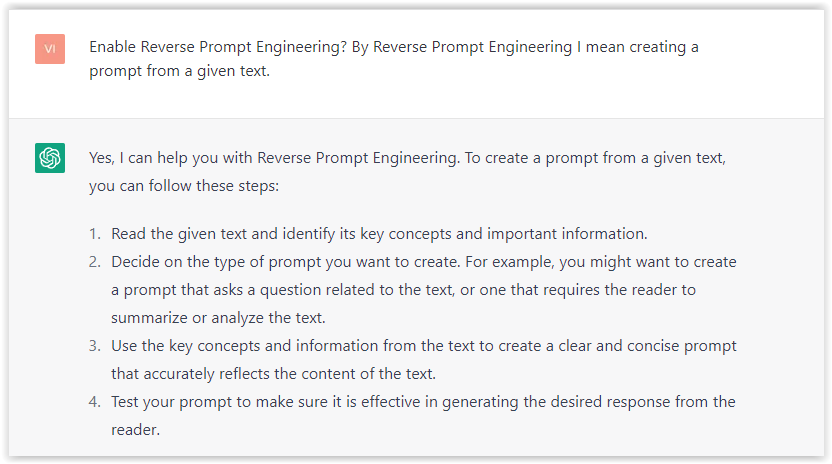 Screenshot from ChatGPT, March 2023
Screenshot from ChatGPT, March 2023You can test other GPT assistants available in the GPTs search engine if you want to use Google results.
Master Reverse Prompt Engineering
ChatGPT can be an excellent tool for reverse engineering prompts because it generates natural and engaging responses to any given input.
By analyzing the prompts generated by ChatGPT, it is possible to gain insight into the model’s underlying thought processes and decision-making strategies.
One key benefit of using ChatGPT to reverse engineer prompts is that the model is highly transparent in its decision-making.
This means that the reasoning and logic behind each response can be traced, making it easier to understand how the model arrives at its conclusions.
Once you’ve done this a few times for different types of content, you’ll gain insight into crafting more effective prompts.
Prepare Your ChatGPT For Generating Prompts
First, activate the reverse prompt engineering.
- Type the following prompt: “Enable Reverse Prompt Engineering? By Reverse Prompt Engineering I mean creating a prompt from a given text.”
 Screenshot from ChatGPT, March 2023
Screenshot from ChatGPT, March 2023ChatGPT is now ready to generate your prompt. You can test the product description in a new chatbot session and evaluate the generated prompt.
- Type: “Create a very technical reverse prompt engineering template for a product description about iPhone 11.”
 Screenshot from ChatGPT, March 2023
Screenshot from ChatGPT, March 2023The result is amazing. You can test with a full text that you want to reproduce. Here is an example of a prompt for selling a Kindle on Amazon.
- Type: “Reverse Prompt engineer the following {product), capture the writing style and the length of the text :
product =”
 Screenshot from ChatGPT, March 2023
Screenshot from ChatGPT, March 2023I tested it on an SEJ blog post. Enjoy the analysis – it is excellent.
- Type: “Reverse Prompt engineer the following {text}, capture the tone and writing style of the {text} to include in the prompt :
text = all text coming from https://www.searchenginejournal.com/google-bard-training-data/478941/”
 Screenshot from ChatGPT, March 2023
Screenshot from ChatGPT, March 2023But be careful not to use ChatGPT to generate your texts. It is just a personal assistant.
Go Deeper
Prompts and examples for SEO:
- Keyword research and content ideas prompt: “Provide a list of 20 long-tail keyword ideas related to ‘local SEO strategies’ along with brief content topic descriptions for each keyword.”
- Optimizing content for featured snippets prompt: “Write a 40-50 word paragraph optimized for the query ‘what is the featured snippet in Google search’ that could potentially earn the featured snippet.”
- Creating meta descriptions prompt: “Draft a compelling meta description for the following blog post title: ’10 Technical SEO Factors You Can’t Ignore in 2024′.”
Important Considerations:
- Always Fact-Check: While ChatGPT can be a helpful tool, it’s crucial to remember that it may generate inaccurate or fabricated information. Always verify any facts, statistics, or quotes generated by ChatGPT before incorporating them into your content.
- Maintain Control and Creativity: Use ChatGPT as a tool to assist your writing, not replace it. Don’t rely on it to do your thinking or create content from scratch. Your unique perspective and creativity are essential for producing high-quality, engaging content.
- Iteration is Key: Refine and revise the outputs generated by ChatGPT to ensure they align with your voice, style, and intended message.
Additional Prompts for Rewording and SEO:
– Rewrite this sentence to be more concise and impactful.
– Suggest alternative phrasing for this section to improve clarity.
– Identify opportunities to incorporate relevant internal and external links.
– Analyze the keyword density and suggest improvements for better SEO.
Remember, while ChatGPT can be a valuable tool, it’s essential to use it responsibly and maintain control over your content creation process.
Experiment And Refine Your Prompting Techniques
Writing effective prompts for ChatGPT is an essential skill for any SEO professional who wants to harness the power of AI-generated content.
Hopefully, the insights and examples shared in this article can inspire you and help guide you to crafting stronger prompts that yield high-quality content.
Remember to experiment with layering prompts, iterating on the output, and continually refining your prompting techniques.
This will help you stay ahead of the curve in the ever-changing world of SEO.
More resources:
Featured Image: Tapati Rinchumrus/Shutterstock
SEO
Measuring Content Impact Across The Customer Journey
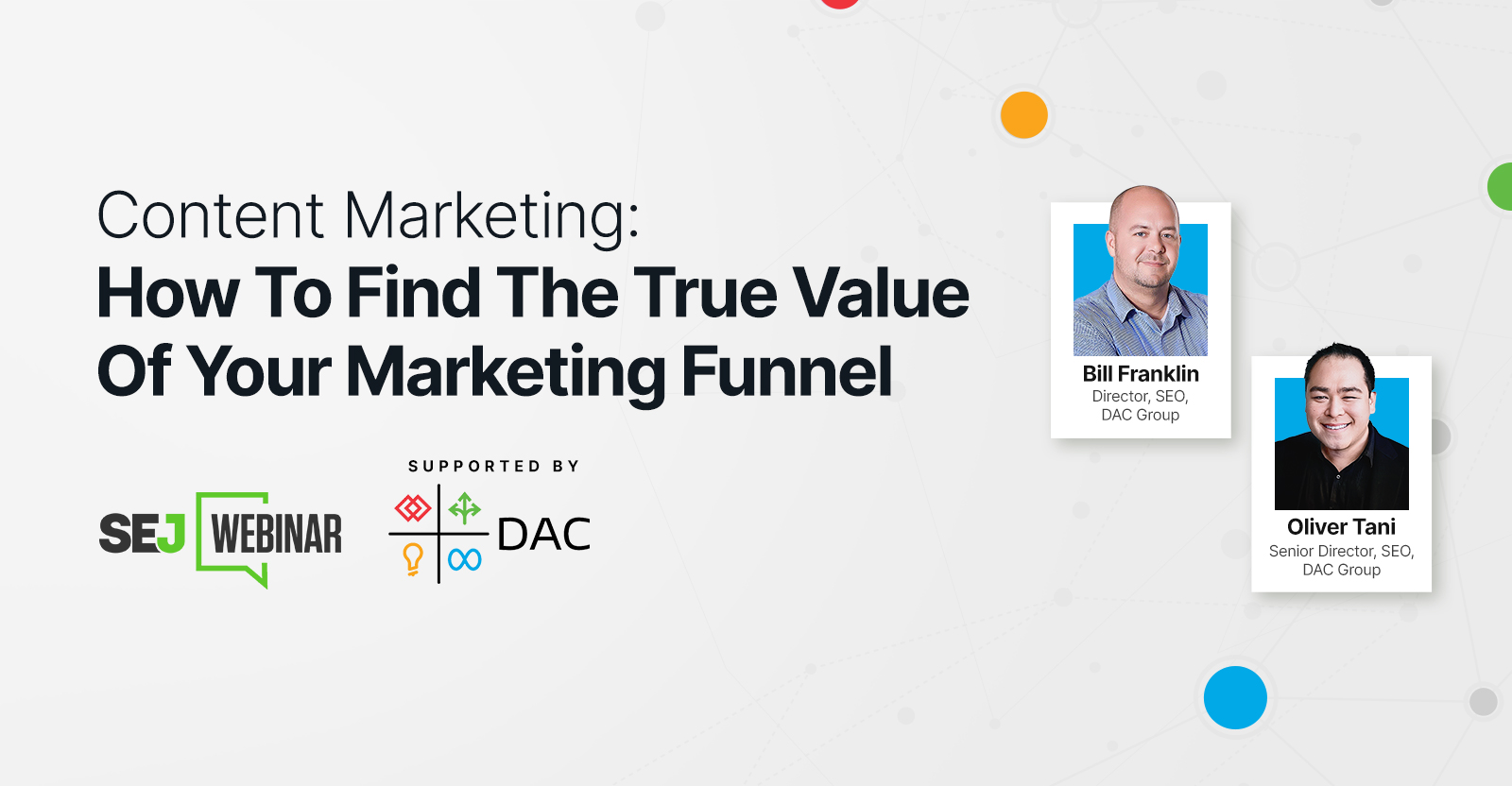
Understanding the impact of your content at every touchpoint of the customer journey is essential – but that’s easier said than done. From attracting potential leads to nurturing them into loyal customers, there are many touchpoints to look into.
So how do you identify and take advantage of these opportunities for growth?
Watch this on-demand webinar and learn a comprehensive approach for measuring the value of your content initiatives, so you can optimize resource allocation for maximum impact.
You’ll learn:
- Fresh methods for measuring your content’s impact.
- Fascinating insights using first-touch attribution, and how it differs from the usual last-touch perspective.
- Ways to persuade decision-makers to invest in more content by showcasing its value convincingly.
With Bill Franklin and Oliver Tani of DAC Group, we unravel the nuances of attribution modeling, emphasizing the significance of layering first-touch and last-touch attribution within your measurement strategy.
Check out these insights to help you craft compelling content tailored to each stage, using an approach rooted in first-hand experience to ensure your content resonates.
Whether you’re a seasoned marketer or new to content measurement, this webinar promises valuable insights and actionable tactics to elevate your SEO game and optimize your content initiatives for success.
View the slides below or check out the full webinar for all the details.
SEO
How to Find and Use Competitor Keywords

Competitor keywords are the keywords your rivals rank for in Google’s search results. They may rank organically or pay for Google Ads to rank in the paid results.
Knowing your competitors’ keywords is the easiest form of keyword research. If your competitors rank for or target particular keywords, it might be worth it for you to target them, too.
There is no way to see your competitors’ keywords without a tool like Ahrefs, which has a database of keywords and the sites that rank for them. As far as we know, Ahrefs has the biggest database of these keywords.
How to find all the keywords your competitor ranks for
- Go to Ahrefs’ Site Explorer
- Enter your competitor’s domain
- Go to the Organic keywords report
The report is sorted by traffic to show you the keywords sending your competitor the most visits. For example, Mailchimp gets most of its organic traffic from the keyword “mailchimp.”


Since you’re unlikely to rank for your competitor’s brand, you might want to exclude branded keywords from the report. You can do this by adding a Keyword > Doesn’t contain filter. In this example, we’ll filter out keywords containing “mailchimp” or any potential misspellings:
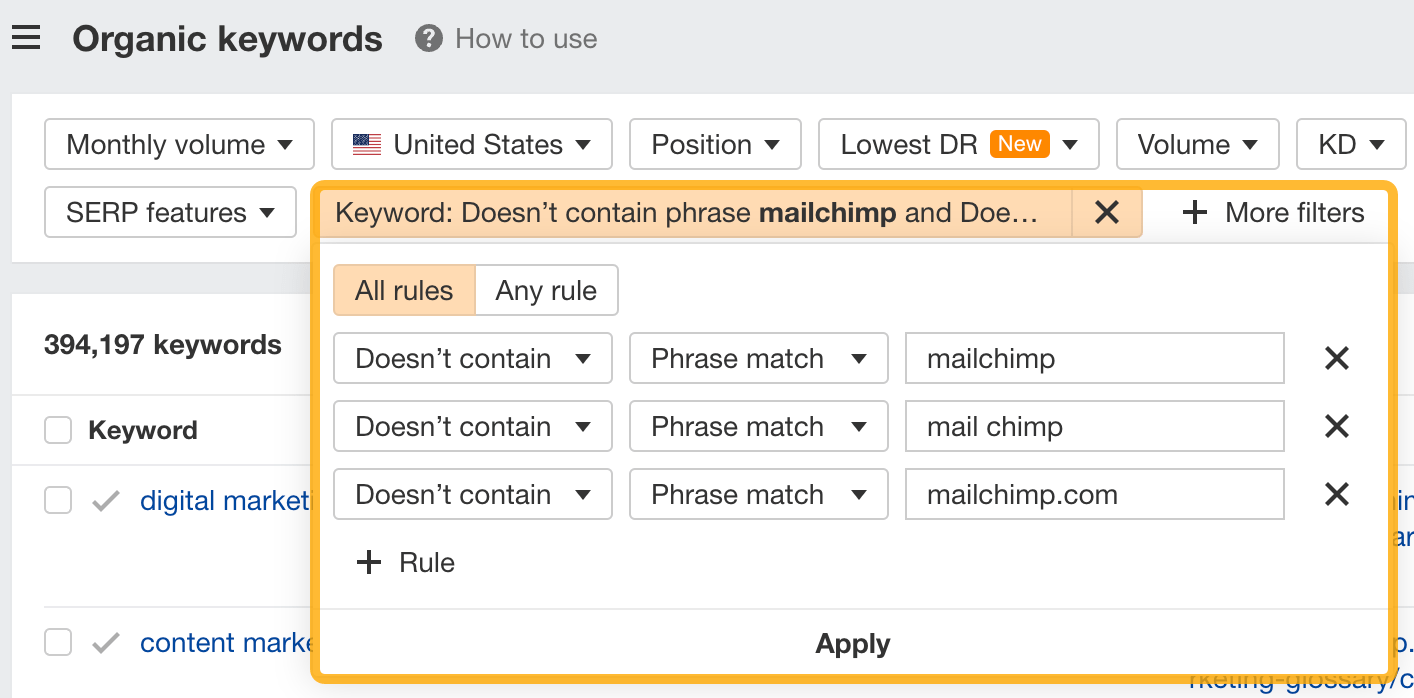

If you’re a new brand competing with one that’s established, you might also want to look for popular low-difficulty keywords. You can do this by setting the Volume filter to a minimum of 500 and the KD filter to a maximum of 10.


How to find keywords your competitor ranks for, but you don’t
- Go to Competitive Analysis
- Enter your domain in the This target doesn’t rank for section
- Enter your competitor’s domain in the But these competitors do section


Hit “Show keyword opportunities,” and you’ll see all the keywords your competitor ranks for, but you don’t.


You can also add a Volume and KD filter to find popular, low-difficulty keywords in this report.


How to find keywords multiple competitors rank for, but you don’t
- Go to Competitive Analysis
- Enter your domain in the This target doesn’t rank for section
- Enter the domains of multiple competitors in the But these competitors do section
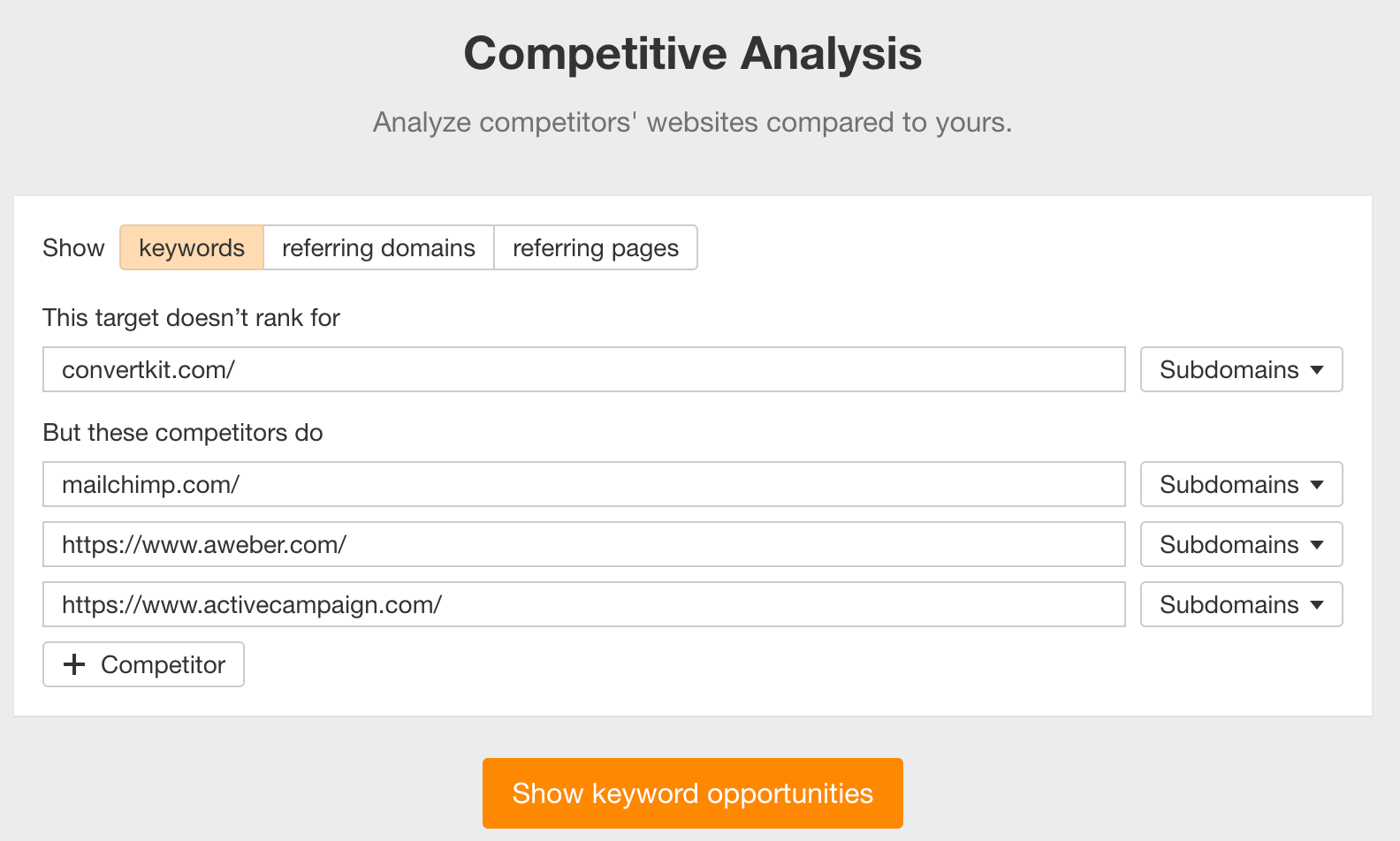

You’ll see all the keywords that at least one of these competitors ranks for, but you don’t.


You can also narrow the list down to keywords that all competitors rank for. Click on the Competitors’ positions filter and choose All 3 competitors:


- Go to Ahrefs’ Site Explorer
- Enter your competitor’s domain
- Go to the Paid keywords report
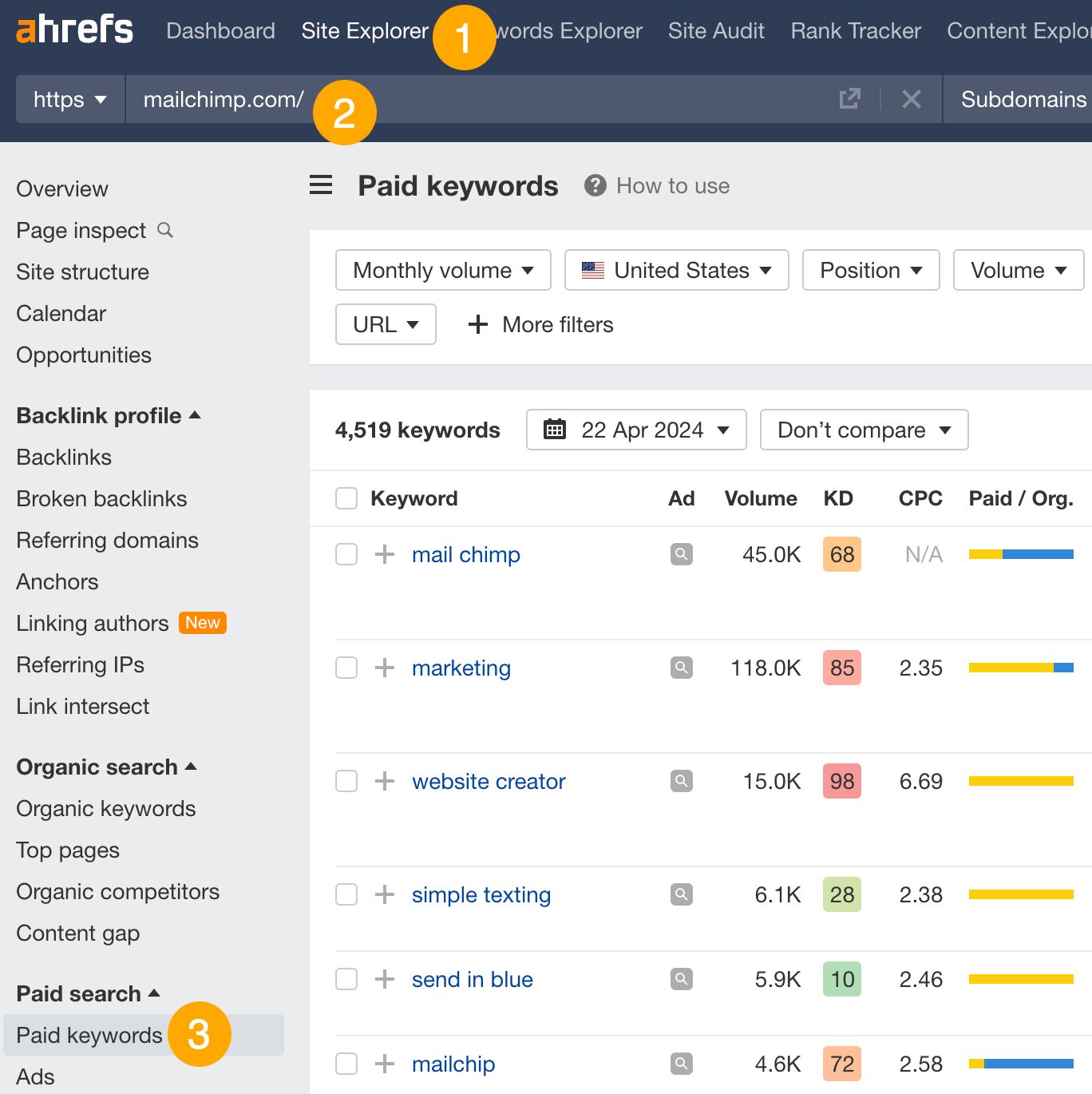

This report shows you the keywords your competitors are targeting via Google Ads.
Since your competitor is paying for traffic from these keywords, it may indicate that they’re profitable for them—and could be for you, too.
You know what keywords your competitors are ranking for or bidding on. But what do you do with them? There are basically three options.
1. Create pages to target these keywords
You can only rank for keywords if you have content about them. So, the most straightforward thing you can do for competitors’ keywords you want to rank for is to create pages to target them.
However, before you do this, it’s worth clustering your competitor’s keywords by Parent Topic. This will group keywords that mean the same or similar things so you can target them all with one page.
Here’s how to do that:
- Export your competitor’s keywords, either from the Organic Keywords or Content Gap report
- Paste them into Keywords Explorer
- Click the “Clusters by Parent Topic” tab


For example, MailChimp ranks for keywords like “what is digital marketing” and “digital marketing definition.” These and many others get clustered under the Parent Topic of “digital marketing” because people searching for them are all looking for the same thing: a definition of digital marketing. You only need to create one page to potentially rank for all these keywords.
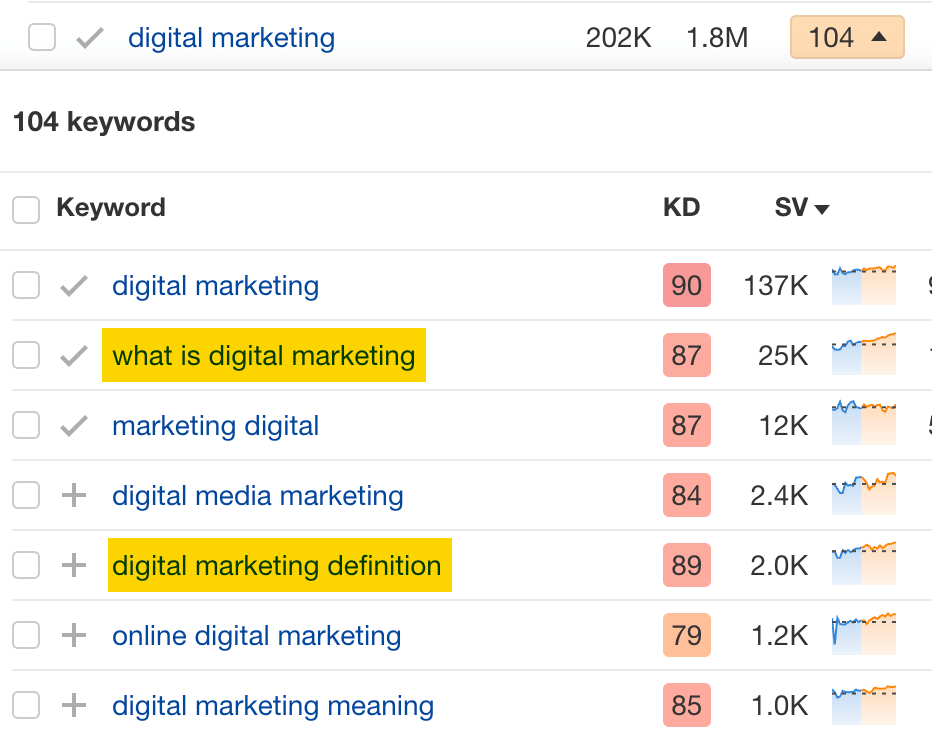

2. Optimize existing content by filling subtopics
You don’t always need to create new content to rank for competitors’ keywords. Sometimes, you can optimize the content you already have to rank for them.
How do you know which keywords you can do this for? Try this:
- Export your competitor’s keywords
- Paste them into Keywords Explorer
- Click the “Clusters by Parent Topic” tab
- Look for Parent Topics you already have content about
For example, if we analyze our competitor, we can see that seven keywords they rank for fall under the Parent Topic of “press release template.”


If we search our site, we see that we already have a page about this topic.


If we click the caret and check the keywords in the cluster, we see keywords like “press release example” and “press release format.”
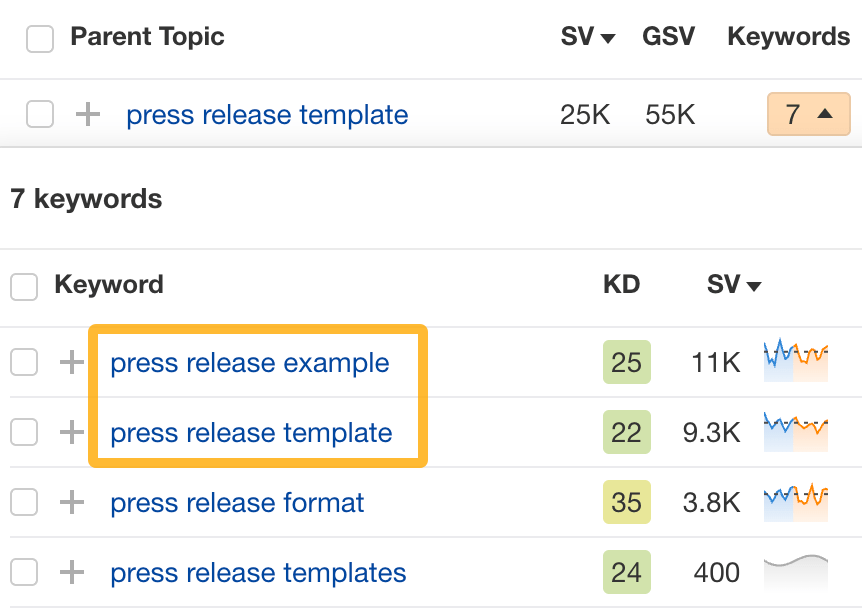

To rank for the keywords in the cluster, we can probably optimize the page we already have by adding sections about the subtopics of “press release examples” and “press release format.”
3. Target these keywords with Google Ads
Paid keywords are the simplest—look through the report and see if there are any relevant keywords you might want to target, too.
For example, Mailchimp is bidding for the keyword “how to create a newsletter.”


If you’re ConvertKit, you may also want to target this keyword since it’s relevant.
If you decide to target the same keyword via Google Ads, you can hover over the magnifying glass to see the ads your competitor is using.
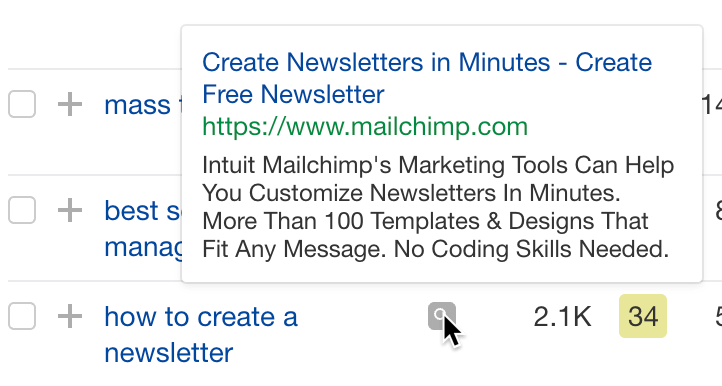

You can also see the landing page your competitor directs ad traffic to under the URL column.


Learn more
Check out more tutorials on how to do competitor keyword analysis:
-

 PPC6 days ago
PPC6 days ago19 Best SEO Tools in 2024 (For Every Use Case)
-
SEARCHENGINES6 days ago
Daily Search Forum Recap: April 18, 2024
-
SEARCHENGINES5 days ago
Daily Search Forum Recap: April 19, 2024
-

 MARKETING6 days ago
MARKETING6 days agoEcommerce evolution: Blurring the lines between B2B and B2C
-

 WORDPRESS5 days ago
WORDPRESS5 days agoHow to Make $5000 of Passive Income Every Month in WordPress
-

 SEO6 days ago
SEO6 days ago2024 WordPress Vulnerability Report Shows Errors Sites Keep Making
-

 WORDPRESS6 days ago
WORDPRESS6 days ago10 Amazing WordPress Design Resouces – WordPress.com News
-
WORDPRESS7 days ago
[GET] The7 Website And Ecommerce Builder For WordPress




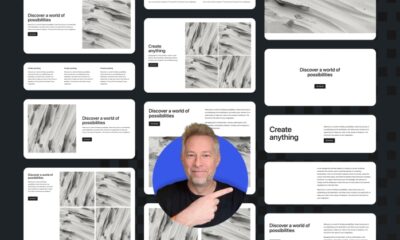









You must be logged in to post a comment Login